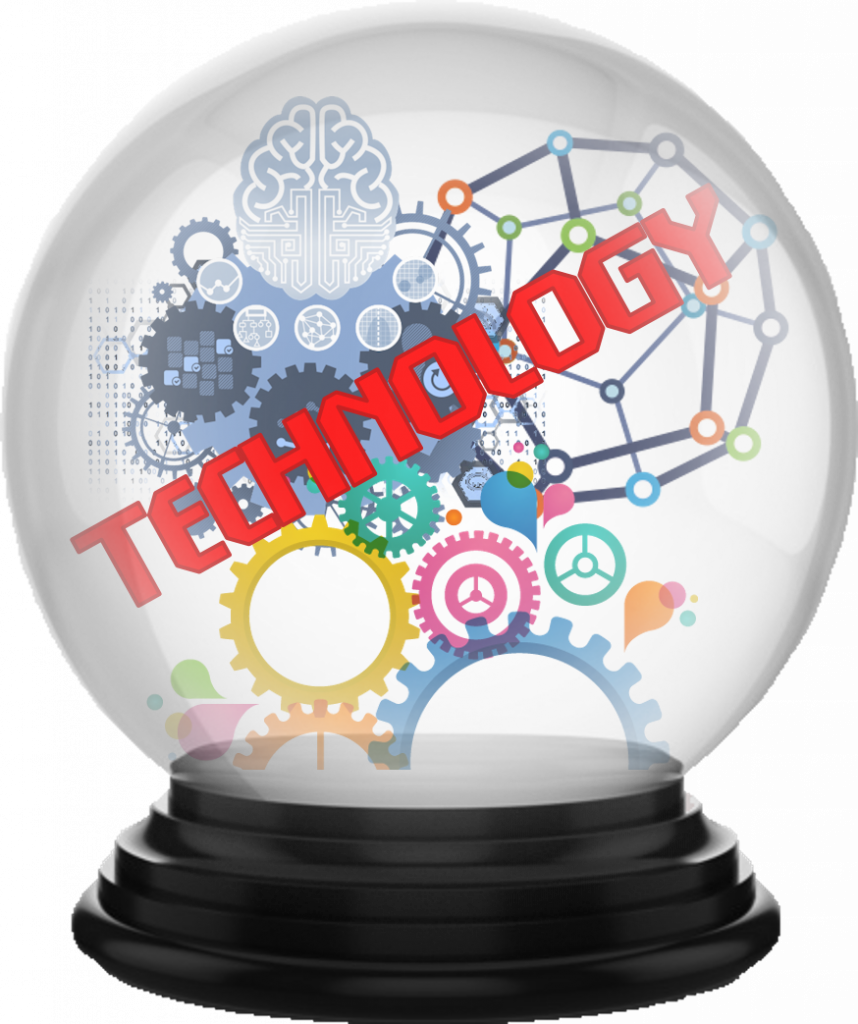Technology covers an enormous range of things; far too many things to be covered in a single article. Nevertheless, it’s interesting to see what kinds of technologies pundits predict will change the world in the years ahead. Prognostication is always an iffy proposition. Jamie Carter writes, “If predicting the future is dumb, then predicting advances in technology is even dumber.”[1] He’s probably correct; but there are couple of interesting rules that can be applied when trying to predict the future. MIT’s Andrew McAfee (@amcafee) indicates he learned to look at the future through a lens taught him by a Google executive. He explains, “Of the many things I’ve learnt from Google’s chief economist Hal Varian, perhaps my favorite is his elegant and thrifty approach to prediction. ‘A simple way to forecast the future,’ he says, ‘is to look at what rich people have today.’ This works.”[2] He adds, “Hal’s point is that tech progress quite quickly makes initially expensive things — both goods and services — cheaper, and so hastens their spread.” He calls this the “Varian Rule.” In areas like healthcare, I can only hope the Varian Rule holds true. Brian Wang uses a different rule (or maybe it’s a complementary rule) to predict the future. He calls it “emerged super technology with trillion dollar impacts.”[3] The basic notion is that any technology that can generate a trillion dollars worth of impact on the global economy will change the future. You might want to keep these rules in mind as I discuss some of technologies pundits suggest will have a significant impact in the years ahead.
Five Technology Areas to Watch
1. Biotechnology. Madhumita Murgia (@madhumita29) notes the Varian Rule seems to be in play in the biotech sector. “Since the early 2000s,” she explains, “the cost of sequencing a human genome — determining the precise order of nucleotides within DNA molecules that defines who we are — has dropped sharply. A genome that cost $100m to sequence in 2001 can today be sequenced for roughly $1,000. This plummeting cost, along with the shortened timescales for sequencing DNA, has led to a revolution in biotechnology: gene hacking, or the ability to turn genes on and off, and to manipulate biology to our advantage.”[4] Wang also believes the biotech sector will change lives. He predicts, “The first antiaging treatment (Metformin) could be approved by the FDA in the next ten years.” He also predicts, “DNA molecular nanotechnology and other molecular nanotechnology will become commercialized over the next ten years in significant ways.”
2. Quantum Computing. Could 2018 finally be the year we see a real breakthrough in the area of quantum computing? Wang predicts, “Universal quantum computers will achieve quantum dominance by the end of 2018. This will benefit AI and genetic engineering and other areas.” Mark van Rijmenam (@VanRijmenam), founder of Datafloq, isn’t so sure 2018 will be the year; but, he agrees quantum computing is on the way. “The developments in quantum computing are going a lot faster than expected,” he writes. “The race for the holy grail of computing is on and companies such as Google, D-Wave and IBM, universities such as Yale and UNSW and startups such as Rigetti Computing are all working on developing quantum computers. Each of these organizations has reported breakthroughs in 2017, with the latest being IBM who announced the first 50-qubit quantum processor in November 2017. A 50-qubit quantum processor is getting closer to quantum supremacy, which IBM now estimates to be at around 57-qubits. Quantum supremacy is defined as the ability of quantum computing to solve problems which can no longer be solved with the world’s fastest supercomputer. Not only organizations are working on achieving this quantum supremacy, but also countries are investing billions in it. China is building the world’s biggest quantum research facility. Their objective is to have a quantum computer by 2020 that has the computational power of a million times all computers in the world combined.”[5]
3. Artificial Intelligence. Artificial Intelligence (AI) has been a popular topic in both scientific and entertainment fields for decades. Murgia notes, “This decades-old science is enjoying a renaissance today because of the deluge of data created by smartphones and sensors, and the supercomputing power that is available to crunch that data. According to technology research firm Tractica, the AI market will grow from $643.7m in 2016 to $36.8bn by 2025.” To date, however, the only real advances in AI have been in so-called narrow AI as opposed to Artificial General Intelligence (i.e., the creation of sentient machines). Nevertheless, Murgia reports companies are working towards creating AGI. “The next step,” she explains, “is artificial general intelligence: an algorithm that will not have to be taught a specific skill such as a game of chess or a new language, but will acquire it through trial and error, just as a child does. Companies such as London-based DeepMind, owned by Google, and others are working to make this a reality.” I’m not holding my breath waiting for a sentient machine to emerge. There are plenty of useful things narrow AI can accomplish in the meantime.
4. Renewable Energy. With air pollution adversely affecting millions of people around the world, even some of the world’s worst polluters are recognizing the benefits of renewable energy. Despite the Trump administration’s withdrawal from the Paris Accords, the rest of the world will likely move ahead on this front. In many areas, solar power is already the principal source of electricity. One of Elon Musk’s companies recently installed the world’s largest battery in Australia’s outback to store electricity generated by solar panels. Wind farms also continue to be built both on land and offshore. What’s next? Murgia writes, “In energy, researchers are trying to build a nuclear fusion reactor that would tap the same process that causes the sun to give off light and heat to create a source of clean energy.” Carter predicts they will eventually succeed in this effort. He explains, “AI and computing power are destined to become the enablers for something 22nd society will need a lot of: energy. Per capita energy consumption is already rising so fast that we’ll need a miracle to prevent humanity from entering a period of energy-starved stasis. Is that miracle nuclear fusion? … AI is currently being used to develop the all-important models of plasma physics, so that scientists can predict how reactions will work. Once we’ve cracked it, humanity will have low-carbon energy forever.”
5 Connectivity. Brookings’ analysts, Adie Tomer (@AdieTomer) and Rob Puentes (@rpuentes), who bluntly state, “No industry or household in the world, will reach their future potential without access to broadband, it is the electricity of the 21st century.”[6] Broadband connectivity is also the sine qua non for the Internet of Things (IoT). Although there is a lot of hype about the IoT, the fact remains a number of challenges need to be overcome before anticipated IoT objectives are achieved. Many analysts are sanguine the challenges will be overcome. The IoT is really an ecosystem consisting of sensors, connectivity, and analytics. Wang notes, “Improved sensors are key to enabling more impactful self-driving cars, drones and robotics.” Murgia adds, “As more objects connect to the ‘internet of things’ — an estimated 50bn of them by 2020, according to estimates from technology company Cisco — the future of WiFi lies in reducing the power it drains from internet-enabled devices. One innovation, invented by students at the University of Washington in Seattle, is known as ‘passive WiFi’ which its inventors say consumes 10,000 times less power. It is currently slower than regular home broadband, but would work well for applications such as smart thermostats or lightbulbs.” Another key technology needed to make the IoT work effectively is edge computing. Van Rijmenam explains, “Edge computing is the key factor to make the Internet of Things work since connected devices will generate so much data that transmitting, storing and analyzing all that data at a central location is no longer viable. Not only that, connected devices such as drones, self-driving cars or robots will, most likely, require extreme rapid processing. Creating the data, sending it to the cloud for analysis and returning the results to the device will simply take up too much time.”
Summary
As noted at the beginning of this article, technology is simply too large of a topic to be covered in a single article. The five technology areas discussed do provide a glimpse into the future and should provide people with a glimmer of hope. Carter asks, “Can technology solve all of humanity’s problems?” His answer: “It can, absolutely – but whether it will or not depends hugely on whether humans allow it to live up to its potential.”
Footnotes
[1] Jamie Carter, “The tech that will power the 22nd century,” TechRadar, 3 December 2017.
[2] Andrew McAfee, “What do the rich have now that will soon spread?” Financial Times, 7 April 2015.
[3] Brian Wang, “Next Big Futures from now to 2027,” Next Big Future, 16 September 2017.
[4] Madhumita Murgia, “Five technologies that will change how we live,” Financial Times, 16 February 2017.
[5] Mark van Rijmenam, “The Top 7 Technology Trends for 2018,” Datafloq, 30 November 2017.
[6] Adie Tomer and Rob Puentes, “Here’s the Right Way to Build the Futuristic Cities of Our Dreams,” Wired, 23 April 2014.



